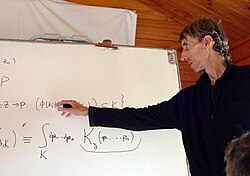Clifford Taubes
| Clifford Taubes | |
|---|---|

Clifford Taubes, 2010.
|
|
| Born | 1954 (age 62–63) Rochester, New York |
| Nationality | United States |
| Fields | Mathematical physics |
| Institutions | Harvard University |
| Alma mater | Harvard University |
| Thesis | The Structure of Static Euclidean Gauge Fields (1980) |
| Doctoral advisor | Arthur Jaffe |
| Doctoral students |
Michael Hutchings Tomasz Mrowka |
| Known for | Taubes's Gromov invariant |
| Notable awards |
Shaw Prize (2009) Clay Research Award (2008) NAS Award in Mathematics (2008) Veblen Prize (1991) |
Clifford Henry Taubes (born 1954) is the William Petschek Professor of Mathematics at Harvard University and works in gauge field theory, differential geometry, and low-dimensional topology. His brother, Gary Taubes, is a science writer.
Taubes received his Ph.D. in physics in 1980 under the direction of Arthur Jaffe, having proven results collected in (Jaffe & Taubes 1980) about the existence of solutions to the Landau–Ginzburg vortex equations and the Bogomol'nyi monopole equations.
Soon, he began applying his gauge-theoretic expertise to pure mathematics. His work on the boundary of the moduli space of solutions to the Yang-Mills equations was used by Simon Donaldson in his proof of Donaldson's theorem. He proved in (Taubes 1987) that R4 has an uncountable number of smooth structures (see also exotic R4), and (with Raoul Bott in Bott & Taubes 1989) proved Witten's rigidity theorem on the elliptic genus.
In a series of four long papers in the 1990s (collected in Taubes 2000), Taubes proved that, on a closed symplectic four-manifold, the (gauge-theoretic) Seiberg–Witten invariant is equal to an invariant which enumerates certain pseudoholomorphic curves and is now known as Taubes's Gromov invariant. This fact has transformed mathematicians' understanding of the topology of symplectic four-manifolds.
...
Wikipedia
